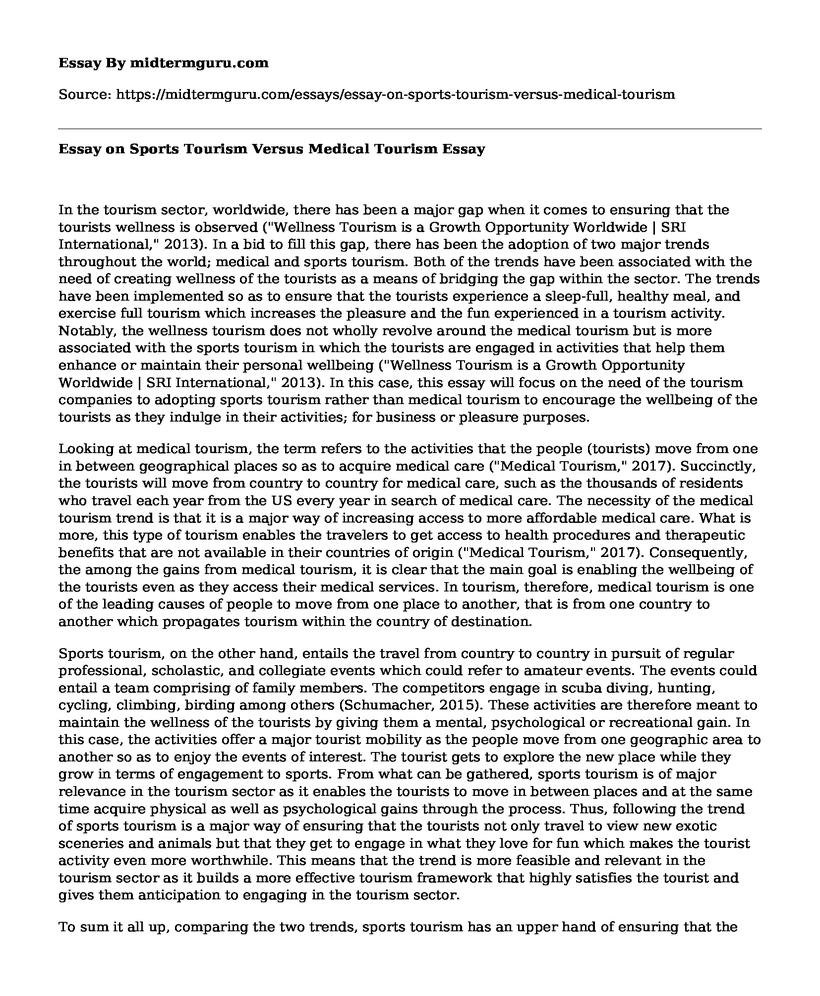In the tourism sector, worldwide, there has been a major gap when it comes to ensuring that the tourists wellness is observed ("Wellness Tourism is a Growth Opportunity Worldwide | SRI International," 2013). In a bid to fill this gap, there has been the adoption of two major trends throughout the world; medical and sports tourism. Both of the trends have been associated with the need of creating wellness of the tourists as a means of bridging the gap within the sector. The trends have been implemented so as to ensure that the tourists experience a sleep-full, healthy meal, and exercise full tourism which increases the pleasure and the fun experienced in a tourism activity. Notably, the wellness tourism does not wholly revolve around the medical tourism but is more associated with the sports tourism in which the tourists are engaged in activities that help them enhance or maintain their personal wellbeing ("Wellness Tourism is a Growth Opportunity Worldwide | SRI International," 2013). In this case, this essay will focus on the need of the tourism companies to adopting sports tourism rather than medical tourism to encourage the wellbeing of the tourists as they indulge in their activities; for business or pleasure purposes.
Looking at medical tourism, the term refers to the activities that the people (tourists) move from one in between geographical places so as to acquire medical care ("Medical Tourism," 2017). Succinctly, the tourists will move from country to country for medical care, such as the thousands of residents who travel each year from the US every year in search of medical care. The necessity of the medical tourism trend is that it is a major way of increasing access to more affordable medical care. What is more, this type of tourism enables the travelers to get access to health procedures and therapeutic benefits that are not available in their countries of origin ("Medical Tourism," 2017). Consequently, the among the gains from medical tourism, it is clear that the main goal is enabling the wellbeing of the tourists even as they access their medical services. In tourism, therefore, medical tourism is one of the leading causes of people to move from one place to another, that is from one country to another which propagates tourism within the country of destination.
Sports tourism, on the other hand, entails the travel from country to country in pursuit of regular professional, scholastic, and collegiate events which could refer to amateur events. The events could entail a team comprising of family members. The competitors engage in scuba diving, hunting, cycling, climbing, birding among others (Schumacher, 2015). These activities are therefore meant to maintain the wellness of the tourists by giving them a mental, psychological or recreational gain. In this case, the activities offer a major tourist mobility as the people move from one geographic area to another so as to enjoy the events of interest. The tourist gets to explore the new place while they grow in terms of engagement to sports. From what can be gathered, sports tourism is of major relevance in the tourism sector as it enables the tourists to move in between places and at the same time acquire physical as well as psychological gains through the process. Thus, following the trend of sports tourism is a major way of ensuring that the tourists not only travel to view new exotic sceneries and animals but that they get to engage in what they love for fun which makes the tourist activity even more worthwhile. This means that the trend is more feasible and relevant in the tourism sector as it builds a more effective tourism framework that highly satisfies the tourist and gives them anticipation to engaging in the tourism sector.
To sum it all up, comparing the two trends, sports tourism has an upper hand of ensuring that the tourist has complete wellness. From the fact that the trend is a voluntary and anticipated event rather than the medical tourism which is as a result of unavoidable health circumstances and the fact that sports tourism is a favorable way of keeping the body fit and healthy, the adaptation of sports tourism is highly recommended. It would be a great strategy for improving the tourism sector if more of the sports activities were added to the normal tourism activities that are perpetrated within the sector. As the major goal of tourism has been creating a recreational satisfaction for the tourists, sport tourism is a very effective way of providing such satisfaction on top of which the trend in tourism enables the tourists to keep fit and maximally enjoy the fruits of fun and team building that is yielded from the specific activities in sport tourism.
References
Medical Tourism. (2016). Centers for Disease Control and Prevention. Retrieved 21 February 2017, from https://www.cdc.gov/features/medicaltourism/
Schumacher, D. (2015). Report on THE SPORTS TOURISM INDUSTRY (1st ed., pp. 1-12). Washington: National Association of Sports Commission. Retrieved from https://www.sportscommissions.org/Portals/sportscommissions/Documents/About/STI_report_Oct_15.pdf
Wellness Tourism is a Growth Opportunity Worldwide | SRI International. (2013). Sri.com. Retrieved 21 February 2017, from https://www.sri.com/blog/wellness-tourism-growth-opportunity-worldwide
Cite this page
Essay on Sports Tourism Versus Medical Tourism. (2021, Jun 04). Retrieved from https://midtermguru.com/essays/essay-on-sports-tourism-versus-medical-tourism
If you are the original author of this essay and no longer wish to have it published on the midtermguru.com website, please click below to request its removal:
- Essay on Tourism: TALC Stage of Italy as a Destination
- Essay on Sports Tourism Versus Medical Tourism
- Paper Example on Tenochtitlan
- Negative Impacts of Tourism on Grenada's MBMPA - Essay Sample
- Marine Debris: The Scourge of Petone Beach Tourism
- Exploring Savannah GA: Solutions for Transport Challenges - Essay Sample
- Exploring Kruger National Park: Lions, Wild Animals, & Documentary - Essay Sample







